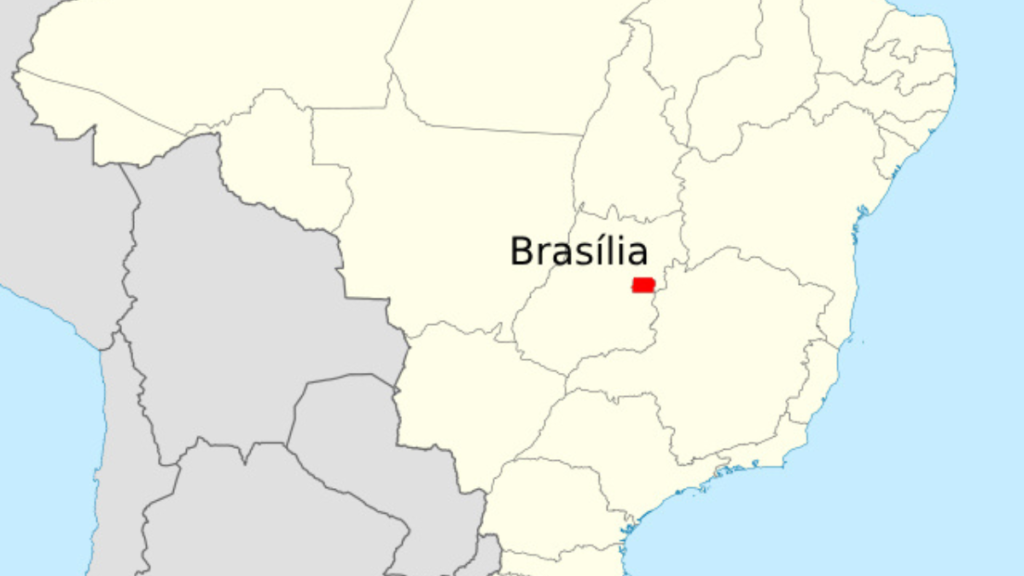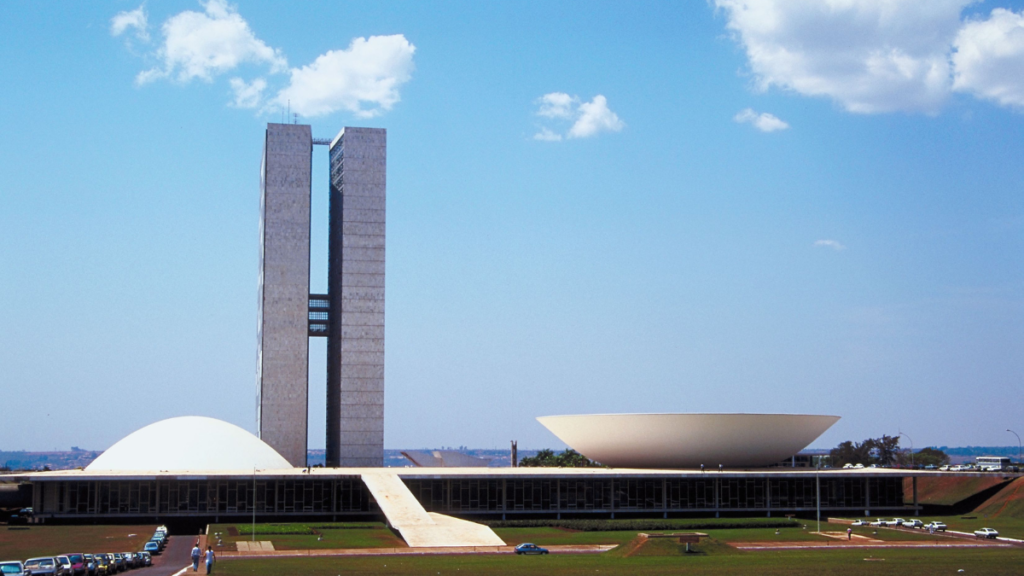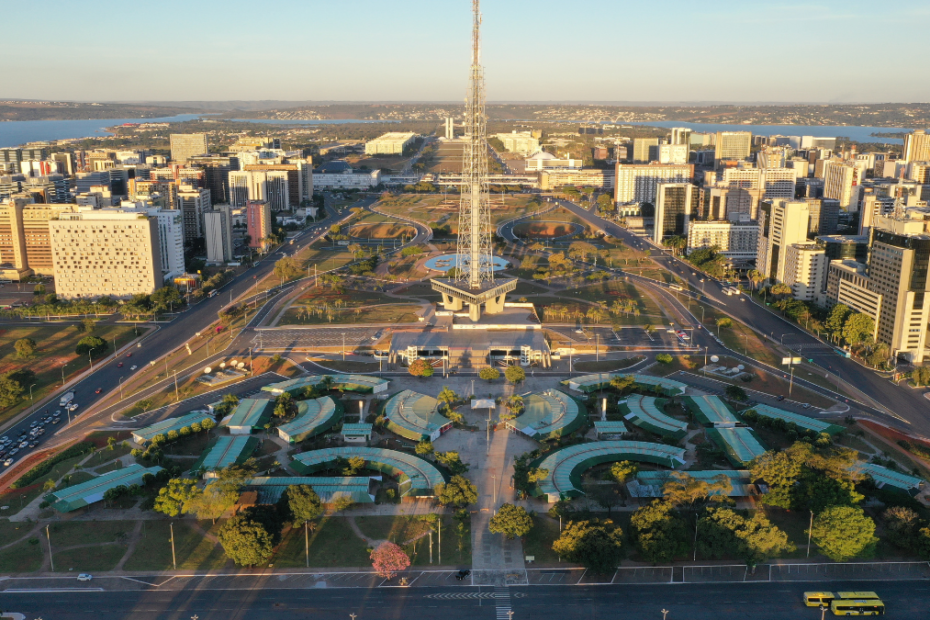- Brasília, is the capital of Brazil since 1960, the city symbolizes Brazil’s ambitions and creativity.
- It features unique architecture, planned by Lúcio Costa and Oscar Niemeyer.
- Brasília’s strategic location facilitates nationwide accessibility.
- The city reflects Brazil’s history, culture, and commitment to sustainable development.
- It contrasts with São Paulo, Brazil’s unofficial cultural and economic capital.
Hey there! If you’re curious about Brazil, you’ve probably heard about its famous beaches, the Amazon rainforest, and, of course, Carnival.
But today, I want to take you on a different kind of journey. We’re going to explore Brasília, the capital of Brazil – a city that’s as fascinating as it is unique.
Now, you might be thinking, “Brasília? Why not Rio or São Paulo?” Well, those cities are amazing in their own right, but Brasília has a story that’s unlike any other.
It’s a city born from a vision, a dream that turned into reality, and it stands today as a testament to Brazil’s ambitions and creativity.
In the next sections, we’ll dive into the history of how Brasília became the capital, explore its unique geography and climate, and take a peek at its vibrant culture and economy.
Whether you’re a history buff, a geography enthusiast, or just someone who loves exploring new places, I promise there’s something in Brasília’s story for you!
The Historical Journey of Brazil’s Capital
Brazil’s journey to finding its perfect capital is like a thrilling novel, filled with twists, turns, and a dash of adventure. Let’s rewind the clock and start at the beginning.
The Early Capital – Salvador
First stop, Salvador, or as it was known back in the day, São Salvador da Bahia de Todos os Santos.
Founded in 1549, Salvador is like the cool grandparent of Brazilian cities – it has seen it all and has stories to tell. This city was the first capital of the Portuguese colony in Brazil and remained so for more than 200 years. Imagine that!
Salvador is more than just a historical footnote. It’s a place where different cultures collided and blended, creating a rich tapestry of Afro-Brazilian heritage that still vibrates through the city today.
The city’s architecture, with its colorful colonial buildings and cobblestone streets, whispers stories of the past. And let’s not forget, it’s one of the oldest planned cities in the world.
But why was Salvador chosen as the capital? Well, its strategic location on the northeast coast made it an ideal spot for Portuguese ships sailing in from Europe.
Salvador was the gateway to Brazil, a place where dreams (and empires) started.

The Shift to Rio de Janeiro
Fast-forward a couple of centuries, and the scene shifts to Rio de Janeiro. By 1763, the Portuguese had a new favorite – Rio.
Why the change, you ask? Well, Rio de Janeiro had a couple of tricks up its sleeve. It had a fabulous port, perfect for the booming coffee and sugar trade. Plus, its location was closer to the mines of Minas Gerais, where gold and diamonds were all the rage.
Rio didn’t just play the role of the capital; it became the beating heart of Brazil, shaping the country’s identity until 1960.
From the colonial era to Brazil’s independence in 1822, and then as the capital of the Republic, Rio was where it all happened.
It was the stage for political dramas, the incubator for cultural movements, and the backdrop for Brazil’s modernization.
Also See | Is a Visa Required to Travel to Brazil? Everything You Need to Know About Entry into Brazil
But, as they say, change is the only constant. As Brazil evolved, so did its needs.
The story of Brasília begins here, but that’s a tale for the next section. For now, let’s raise a toast to Salvador and Rio, the cities that paved the way for what was to come.

Plan your trip to Brazil
-
Find the cheapest flights -
Discover the best accommodation -
Explore this incredible country with the best experiences -
Stay connected at all times with an eSIM
Brasília: The Vision and Design
Brasília isn’t just a city; it’s a piece of art. When you stroll through its streets, you’re walking inside a visionary’s dream, a futuristic design that came to life.
Let’s delve into the minds behind this masterpiece and why the world sits up and takes notice.
Architectural Marvels by Lúcio Costa, Oscar Niemeyer, and Joaquim Cardozo
Picture this: it’s the 1950s, and Brazil decides it needs a new capital. But not just any capital – a symbol of progress, a city of the future.
Enter Lúcio Costa, Oscar Niemeyer, and Joaquim Cardozo. These guys were like the rock stars of architecture and engineering. They didn’t just build a city; they created a legend.
Lúcio Costa was the master planner. He envisioned Brasília as a plane, or some say a bird or an arrow, symbolizing movement and progress.
Also See | Brazil Money: From its Exchange Rate To Its History
This wasn’t just about streets and buildings; it was about creating a city that reflected Brazil’s aspirations.
Then there’s Oscar Niemeyer. Oh boy, did he leave his mark! Niemeyer was all about curves. He believed that “the curve is the essence of the universe.” His buildings in Brasília are like poetry in concrete, with their sweeping curves and bold, daring designs.
From the Cathedral of Brasília with its heavenly white columns reaching for the sky to the National Congress building with its distinctive dish-like structures, Niemeyer’s touch is everywhere.
And let’s not forget Joaquim Cardozo, the engineer who turned these bold ideas into reality. His calculations and technical expertise ensured that Niemeyer’s creative visions stood strong and proud.

UNESCO World Heritage Status
In 1987, UNESCO looked at Brasília and said, “This is something special.” And they were right. Brasília was declared a World Heritage Site, and for good reasons.
Firstly, it’s a prime example of modernist architecture on a grand scale. The city broke new ground in urban planning, turning traditional ideas on their head.
Its design was revolutionary, a city built from scratch, with a unique layout and stunning structures that challenged the norms.
But it’s not just about the architecture. Brasília is a symbol of Brazil’s rebirth, a country shaking off its colonial past and stepping boldly into a new era. It represents the optimism and ambition of a nation, and that’s something truly special.
In Brasília, every street, every building tells a part of Brazil’s story. It’s a city that’s not just lived in but experienced, a place where art, history, and dreams intertwine.
So, when you visit Brasília, remember, you’re not just in a city; you’re in a living, breathing piece of history.
Also See | Brazil Carnival: A Vibrant Mosaic of Cultural Celebrations
Geographic and Climatic Profile of Brasília
Alright, now let’s talk about where Brasília sits on the map and the kind of weather you can expect. It’s not just about the buildings and history; the very land and climate of Brasília play a huge role in its charm and challenges.
Location and Topography
Brasília is like a hidden gem tucked away in the Brazilian highlands. It’s perched proudly at an elevation of about 1,200 meters, which is pretty high up, right?
This isn’t just a random choice. The city’s location was a strategic decision to bring the capital closer to the geographical center of Brazil, making it more accessible from all corners of the country.
The Brazilian highlands, where Brasília is located, are a vast and varied landscape. We’re talking rolling hills, wide plateaus, and some seriously stunning scenery.
This region is the heartland of Brazil, a bridge between various regions. It’s like Brasília is saying, “Hey, I’m right here in the middle, so everyone can reach me!”

The Climate of Brasília
Now, let’s chat about the weather. If you’re expecting the tropical, humid climate that Brazil is famous for, Brasília might surprise you.
The city enjoys a tropical savanna climate. What does that mean for you? Well, it means Brasília experiences a unique blend of wet and dry seasons.
From May to September, it’s dry, with clear blue skies and starry nights. The air is crisp, and it’s a great time for outdoor activities.
Then comes the rainy season from October to April, transforming the landscape into a lush, green paradise.
This climate plays a big role in the life of the city. It shapes everything from the architecture (think large overhangs for shade) to the leisure activities.
Picture this: it’s a dry, sunny day, and you’re exploring the city, enjoying the open spaces and modernist buildings under the vast Brasília sky. Sounds pretty good, right?
So there you have it, the geography and climate of Brasília. It’s a city that’s not just about its location, but how its unique setting shapes its identity and lifestyle.
Whether you’re basking in the dry season sun or dancing in the tropical rain, Brasília has a way of enchanting you with its natural charm.
Brasília’s Significant Landmarks and Attractions
Brasília isn’t just about government and politics; it’s also a city brimming with remarkable landmarks and attractions.
Whether you’re into history, architecture, or just love a bit of outdoor adventure, Brasília has something for everyone. Let’s check out some must-see spots!
Governmental and Historical Buildings
- Praça dos Três Poderes: This is where the magic happens, folks! The ‘Square of the Three Powers’ is the heart of Brazilian political life. Here, you’ll find the iconic buildings of the three branches of government: the Supreme Court, the Presidential Palace, and the National Congress. It’s like a live civics lesson but way cooler.
- Congresso Nacional (National Congress): This isn’t your average parliamentary building. Designed by Oscar Niemeyer, its unique structure, comprising two vertical towers flanked by two hemispherical domes, makes it a striking symbol of Brasília.
- Palácio dos Arcos (Palace of the Arches): Also known as Palácio Itamaraty, this is where Brazil’s Ministry of Foreign Affairs resides. The building is a stunning example of modernist architecture, surrounded by beautiful gardens and water features.

Architectural and Cultural Sites
- Catedral Metropolitana Nossa Senhora Aparecida (Cathedral of Brasília): This architectural marvel will leave you in awe. The cathedral’s 16 curved columns form a crown-like structure, symbolizing hands reaching up to heaven. Inside, the play of light and shadow creates a serene, almost otherworldly experience.
- President Kubitschek Memorial: Dedicated to Juscelino Kubitschek, the founder of Brasília and a former president, this memorial is a tribute to the man who dreamed of a new capital. It’s not just a mausoleum, but a museum filled with artifacts and exhibits about his life and the city’s creation.

Natural Attractions and Recreational Spots
- Lake Paranoá: Created alongside Brasília, this artificial lake is a hub for leisure and recreation. Whether you’re into water sports, fancy a peaceful boat ride, or just want to enjoy a meal by the water, Lake Paranoá is the place to be.
- Brasília National Park: A breath of fresh air in the middle of the city. Known locally as Água Mineral, this park is home to natural springs, walking trails, and a diverse range of wildlife. It’s a perfect escape for nature lovers and those looking to unwind in the great outdoors.

The Evolution of Brasília Since Its Inception
Brasília has come a long way since its inauguration as Brazil’s capital in 1960. This city, once a bold architectural experiment, has blossomed into a dynamic metropolis, constantly evolving and adapting.
Let’s take a look at how Brasília has grown and what it looks like today.
Population Growth and Urban Development
In the beginning, Brasília was like a blank canvas, a newly built city waiting to be filled. And fill it did! People from all over Brazil flocked to the city, drawn by the promise of opportunities and a new way of life.
This internal migration sparked rapid population growth and urban expansion.
The city’s population has surged over the decades, making it one of the largest cities in Brazil. This growth wasn’t just in numbers; it brought diversity and vibrancy to the city’s culture and economy.
As more people arrived, new neighborhoods sprang up, businesses flourished, and Brasília’s urban landscape continually transformed.
This expansion brought challenges, too. Like any growing city, Brasília had to grapple with issues like urban planning, housing, and transportation.
But, true to its innovative spirit, the city has been continuously adapting and evolving to meet these challenges.
Brasília Today – Balancing Heritage and Modernity
Today’s Brasília is a fascinating blend of its original visionary design and the realities of a modern, bustling metropolis. The city honors its architectural heritage – those iconic buildings and planned layouts – while also embracing modernity.
But Brasília is not just resting on its laurels. The city faces contemporary challenges like any other major urban center.
Balancing urban development with environmental sustainability, addressing social inequalities, and maintaining its cultural heritage while fostering economic growth are all on the agenda.
Looking ahead, Brasília is poised to continue its journey. The city is focusing on sustainable development, technological innovation, and enhancing the quality of life for its residents.
There’s a sense of optimism and ambition in the air, much like the spirit that led to the city’s creation.
Economic Landscape of Brasília
Brasília isn’t just the political heart of Brazil; it’s also a buzzing hive of economic activity. But what really makes its economy tick? Let’s take a closer look at how this city balances its role as the administrative powerhouse with a commitment to sustainable development.
Government-Driven Economy
First things first, the government is the big player here. As the capital, Brasília is the epicenter of Brazilian politics and administration.
This means a significant portion of the city’s economy revolves around government services. From civil servants to diplomats, the public sector employs a huge chunk of Brasília’s workforce.
But it’s not just about government jobs. This concentration of administrative activities has a ripple effect, stimulating other sectors like banking, finance, and legal services.
These industries thrive in the city, supported by the constant buzz of governmental activities.
Moreover, Brasília also serves as the headquarters for numerous public companies and institutions.
This presence not only provides employment but also attracts a range of professionals from across Brazil, adding to the city’s dynamic and diverse workforce.
Environmental Considerations in Economic Development
Now, here’s something we Brasilienses are proud of: our city’s focus on sustainable and environmentally friendly industries. You see, when you live in a city that’s a UNESCO World Heritage Site, you learn to value the environment.
In Brasília, there’s a concerted effort to develop industries that are kind to our planet. We’re talking about sectors like film, software, and video production.
These industries not only create jobs and contribute to the economy, but they do so without leaving a heavy carbon footprint.
This green approach also extends to urban planning and public transportation. The city encourages projects that promote sustainability, like efficient public transport systems and green spaces.
It’s all about striking a balance between economic growth and preserving the beauty and integrity of our surroundings.
In essence, Brasília’s economy is a blend of government-driven sectors and innovative, environmentally conscious industries.
It’s a city that’s not just thinking about the now, but also the future – a place where economic growth goes hand in hand with sustainability. And in today’s world, that’s something truly special.
The Unofficial Capital – São Paulo
Now, let’s take a slight detour from Brasília to talk about São Paulo, a city that Brazilians affectionately call “the unofficial capital.” While Brasília is the heart of politics, São Paulo pulses with cultural and economic life like no other city in Brazil.

São Paulo’s Cultural and Economic Influence
São Paulo is like the New York City of Brazil – a melting pot of cultures, ideas, and energies. It’s the largest city in Brazil and the economic powerhouse of the country.
This city doesn’t just keep up with the times; it sets the pace.
Culturally, São Paulo is a dynamo. The city is brimming with art, music, theatre, and cuisine from every corner of the world. It’s home to the São Paulo Art Biennial, the second-oldest art biennial in the world, right after Venice.
And when it comes to food, oh, you’re in for a treat! São Paulo is a gastronomic wonderland, offering everything from street food to Michelin-starred restaurants.
But São Paulo’s influence goes beyond just culture and food. It’s the financial center of Brazil, home to the São Paulo Stock Exchange and countless corporate headquarters.
The city drives innovation and entrepreneurship, making it a magnet for business minds and creative souls alike.
In short, while Brasília is the administrative capital, São Paulo is the beating heart of Brazil’s cultural and economic life.
It’s a city that never sleeps, constantly buzzing with activity and innovation. So, if you want to feel the pulse of modern Brazil, São Paulo is the place to be.
Brasília: Reflecting on a Visionary Journey
As we wrap up our journey through Brasília, it’s clear that this city is far more than just the administrative capital of Brazil. It’s a symbol of the nation’s dreams, ambitions, and spirit.
From its visionary design and architecture to its role in shaping Brazil’s modern identity, Brasília stands as a testament to the country’s dynamic character.
Brasília is not just about grand buildings and political power. It’s a city that tells the story of Brazil’s past, reflects its present, and looks towards its future.
The city’s historical significance as a planned capital, its cultural diversity, and its ongoing evolution capture the essence of Brazil – a nation always in motion, always growing, always vibrant.
Did you like our content, do you want to get to know our country?! Discover the best experiences to live in Brazil!




